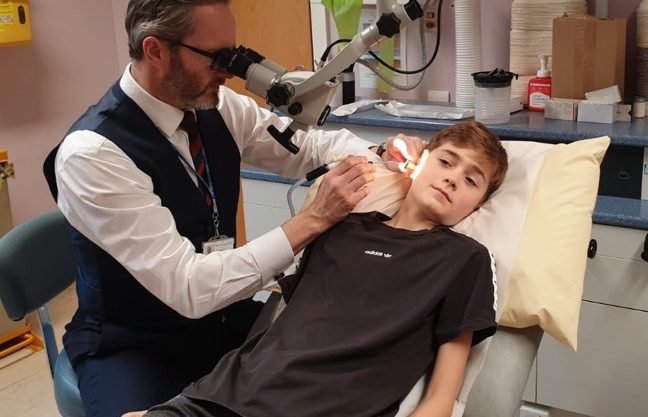Ear Conditions
Hearing and deafness
Hearing loss is common and can affect people at any age. About 16% of adults in the UK have a hearing loss of some kind. There are different types of deafness. Some are caused by problems with the cochlear or the nerve of hearing, while others are caused by middle ear fluid (glue ear).
Some people experience problems with the ear drum or the tiny hearing bones in the middle ear. Hearing loss can interfere with a person’s ability to communicate with others. Treatment depends on the underlying cause and can include surgery or needing to have a hearing aid fitted.

A hole in your eardrum
A hole in your eardrum may have been caused by an infection or an injury. Usually such a hole will heal by itself. If it does not heal it may cause recurrent infections or a hearing loss. Simple measures such as preventing water from getting down your ear may prevent further infections but sometimes an operation to repair the hole, called Myringoplasty is required.
Protruding ears
Protruding ears is usually due to a weakness in part of the ear cartilage. It can sometimes cause the child distress, especially if he or she is being teased at school. Surgical correction called “pinnaplasty” can be performed but not usually before the child is six years old. The cartilage is stronger and I like the child to be mature enough to understand what is happening to them as this makes for a smoother recovery and ultimately the best result. The operation involves a general anaesthetic. I make a cut behind the ear and create a natural looking fold in the cartilage which pulls the ear inwards towards the head. A head bandage is then left in place for two weeks to help the ears heal in their new position. This can be a little itchy and uncomfortable for the child and is another reason why I advocate waiting until they are at least six years of age so that they understand why they need to wear the bandage. I then ask the child to wear an elasticated headband over their ears for another 4 weeks at night-time only.
Dizziness
There are lots of causes of dizziness which may have nothing to do with the balance organ in the inner ear. Fainting, heart, thyroid, eye, brain and nerve disorders can all make you feel dizzy. One type of dizziness is “vertigo” which is the sensation of the room moving or spinning in relation to the patient. Vertigo is specifically linked to problems with the inner ear. There are different types of inner ear dizziness that all require different treatment. I can diagnose most causes of dizziness by asking you lots of specific questions and performing a balance assessment in clinic.
Tinnitus (abnormal sound in the ears)
Tinnitus is a term used to describe a condition where patients hear noises in their ears or in their head. Tinnitus is sometimes called ‘the sound of silence’ because everyone, if they are seated in a completely quiet soundproofed room, will hear a type of rushing or hissing sound. Usually this sound is masked by everyday environmental noise. It is when this type of noise becomes intrusive into everyday life that it can become irritating and is known as ‘tinnitus’. The more anxious the sufferer feels the worse the tinnitus becomes. Sometimes the tinnitus is accompanied by a hearing loss and by using a hearing aid the tinnitus can be diminished. This is because background noise is amplified by the hearing aid, which “masks” the annoying sound. In certain cases if the tinnitus is particularly intrusive I may refer you to a specialist tinnitus therapist.
Glue ear and grommets
Glue ear is a condition in which fluid accumulates behind the ear drum. The build up of fluid in the middle ear is due to a problem with the Eustachian tube. It occurs more frequently in childhood but can affect adults as well, especially after a common cold. It is the most common cause of deafness in children and most children will experience it at some point in time. Most will only have it for a few weeks and will improve with no treatment. A few children will suffer with it for months or years at a time and may experience problems hearing at school. They may also have speech delay issues, mispronounce certain sounds and exhibit behavioral problems. Treatment depends on various factors such as the childs age, level of hearing, problems with speech, language and behavior. Many children will find this clears up in time. Therefore I generally advocate a “watch and wait” policy and will review/examine your child at least two appointments, 3 months apart, before deciding whether or not to treat. If treatment is recommended then this is either grommets (ventilation tubes) or a hearing aid until the glue ear has resolved by itself. Most parents opt to have grommets which requires a short anaesthetic. A small hole is made in the ear drum, the glue is suctioned from the middle ear and a tiny plastic tube is placed through the hole to keep it open. This ventilates the middle ear and prevents more glue from accumulating. The tube usually falls out by itself usually approximately 12 months later. Rarely the grommet gets infected or a hole is left in the ear drum once the grommet falls out.

If you would like more information on ear conditions please CLICK HERE